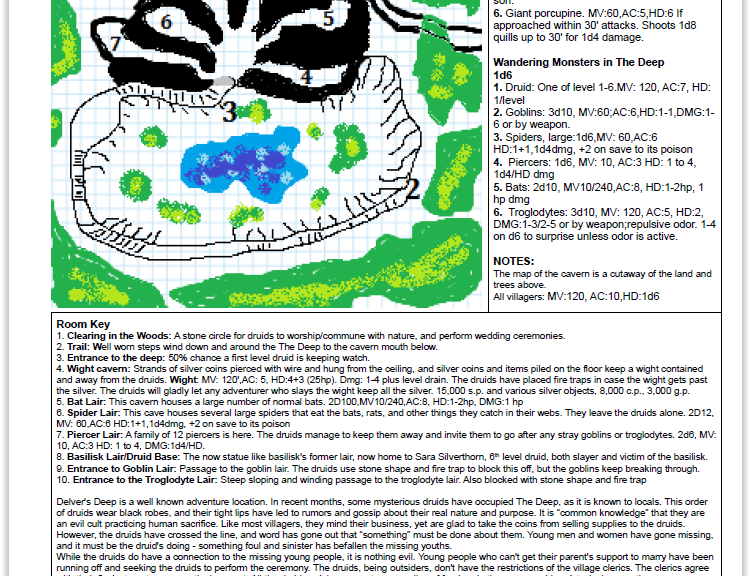W – Waste Disposal/Toilets/Outhouses/Sewers/Drains/Teleporters/Gelatinous Cubes/Otyughs/etc.
Water, food, and other things come into the city. This results in an unpleasant production that needs to be handled to avoid unpleasant odors and disease in the close quarters of a city. Even with clerics and paladins running around to cure disease, they could not heal everyone in a major plague.
Disintegrators could be used for the most hazardous waste, gelatinous cubes could be an invention for waste disposal and they become a menace in the collapse of a fallen city. Otyughs and other carrion eaters could be placed in the sewers to deal with waste, and could still be down there.
Breaking a barrier between the water supply and the sewer system could be more dangerous than mere exposure to disease. It could allow carrion eaters to get to other places. It could flood the sewers and drown the players, etc.
I can see a waste disposal/sewer system that is “dry”, that is there is not large amount of water coursing through it, if storm drains shunt water elsewhere. Gelatinous cubes and carrion eaters would go from one concentration of waste to another, removing what nutrients they can get from it. Even a fallen city, where the sewers are mostly intact might have some form of occupation that leads to waste, small animals, lost humanoids or adventurers. The sewers with such critters to handle the waste would have areas of near pristine, floors walls, and ceilings as all the contents of the sewer is picked clean. Any minimal accumulation of waste will “move” or “appear” and “disappear” as any PC’s explore.”Something” is down there but what?
I mentioned a series of teleporters to move about the ancient cities and empire. Such technology need not move people and goods. Using teleporters to move waste elsewhere could have interesting results. The location that receives the waste could have a huge number of carrion eating monsters. Anyone transported by this means, will have a nasty surprise both in waste and in what eats the waste. Such teleporters could either be constant, whatever enters the area of the teleporter is instantly transported, or it could cycle every so many hours or days.
Finally, disintegrators could be used for the most dangerous waste. Poof, it’s gone. Anyone or anything wandering into these areas would have some signs of warning, perhaps bars to block access. Bars might indicate blocking something valuable. It could be interesting to see characters break in to check out a room that is a disintegrator. Much like the teleporters, are the disintegrators always on, or do they have a cycle of so many hours?
Is the rain water/flood control using the same channels as the sewers? In an arid climate, minimal water would be used to move waste, as much water as possible would need to be gathered for later consumption.
Are there public latrines? Do people have latrines in their homes and businesses, or do they use chamber pots and haul the waste to a neighborhood waste pit? If gelatinous cubes and other dangerous carrion eaters are used to deal with waste, there would need to be some mechanism to prevent them attacking the populace. Only someone foolish enough to go into the sewers would counteract such safety measures.
Maps and adventures don’t often touch on the actual waste and chamber pots and latrines. However, if one is to use carrion based monsters, many of them presuppose waste. For villages, and even towns, they wouldn’t go to the efforts to deal with waste that is needed in the crowded confines of a bustling city. Chamber pots, outhouses, a back corner of the yard, or area outside the town limits is where human waste would be collected. Human waste can be composted for use in gardens, but it has to be extra hot in its composting method to use it on food crops. When human waste is used for fertilizing food crops, it often leads to the spread of disease.
What do guards on watch use? A latrine in the corner of the guard tower, or a chamber pot, or just over the outside of the wall? How common is it to be walking down the street and someone toss out their chamber pot to the street below? What is the chance that someone rises in the middle of the night to take care of business and dumps the chamber pot, with bleary eyes, to the street below and it hits the thieve(s) sneaking about on their way to or from their latest heist? If on their way to their heist, are they “marked” so well, that they decide to postpone, either long enough to get cleaned up, or for another night? Is the nature of the heist one that they can’t re-schedule? If this happens after the heist, is it close enough to the location of the heist that it makes them easier to track?
UPDATE: May 31, 2015 – I found this article at the Register about London’s sewer system. the key point is that it still dumped into the river, just not where there was a large enough concentration of people to complain about the stink. Also, the capacity of the system when originally built 150 years ago, was such that a large part of the current sewage system of London still uses it.







